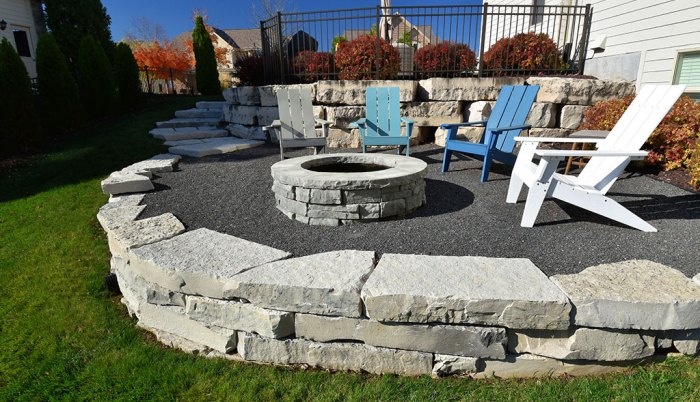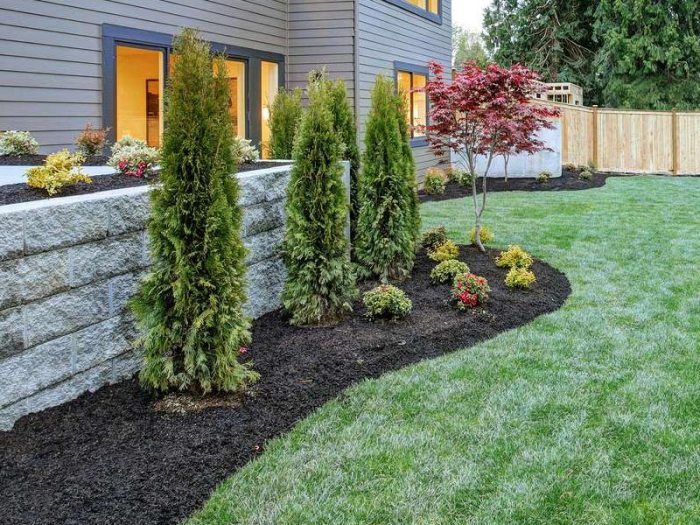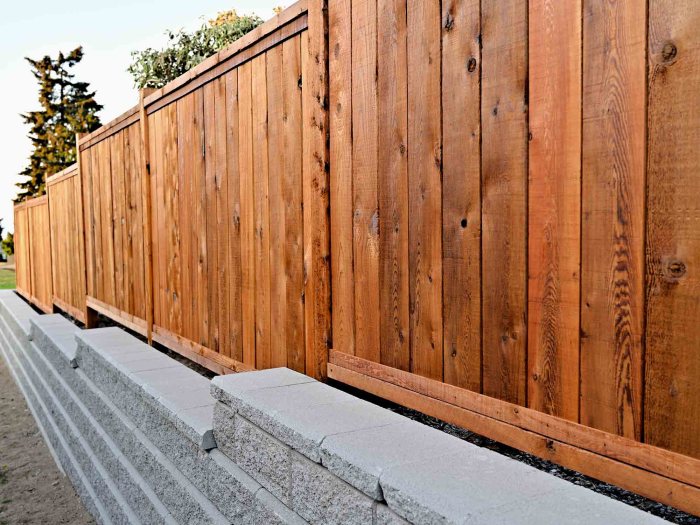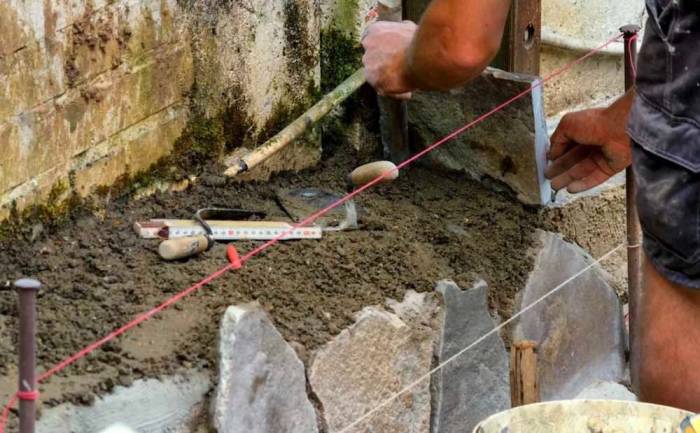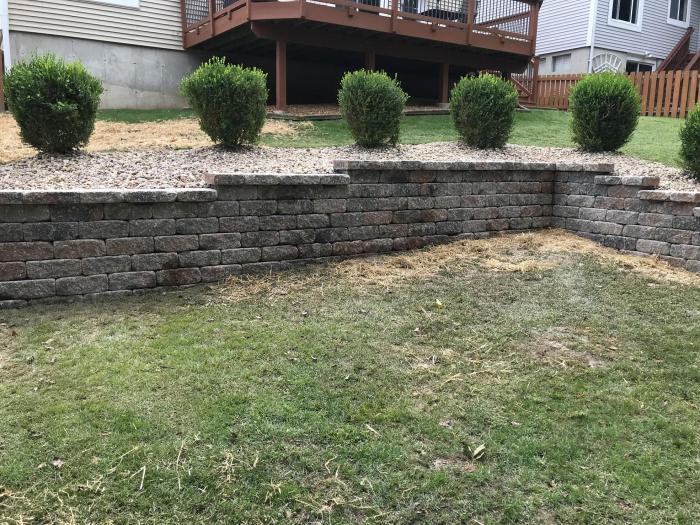Landscape Walls Near Me Your Guide
Landscape walls near me are a fantastic way to elevate your garden’s design. They offer a blend of function and aesthetics, from enhancing privacy and security to defining different garden spaces. This comprehensive guide explores various types of landscape walls, local providers, installation, design inspiration, cost considerations, and integration with existing gardens, equipping you with the knowledge to make informed decisions.
We’ll delve into the different materials used for landscape walls, examining their cost, durability, and aesthetic appeal. You’ll also find valuable insights into selecting the right contractor and understanding installation best practices, including crucial aspects like drainage and soil preparation.
Defining Landscape Walls: Landscape Walls Near Me
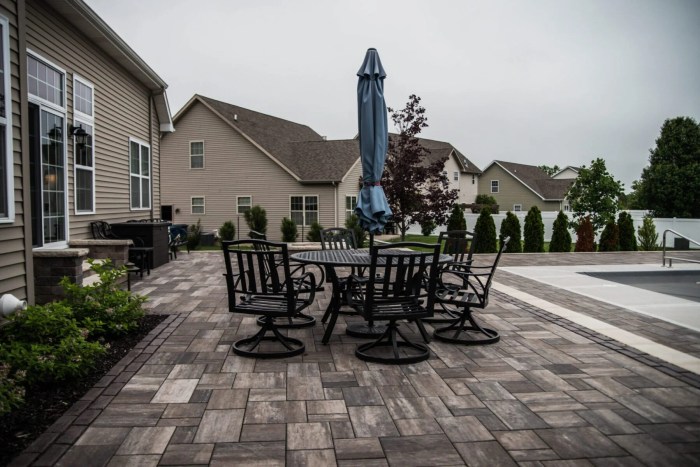
Source: bladecutters.net
Landscape walls, a versatile addition to any garden design, provide both functional and aesthetic benefits. They can define spaces, enhance visual appeal, and even solve practical issues like retaining soil or creating tiered planting areas. Understanding the different types and considerations involved in choosing the right wall is key to achieving a successful and harmonious garden.
Types of Landscape Walls
Landscape walls encompass a wide array of structures, each with its characteristics. Beyond the purely functional retaining wall, decorative landscape walls add visual interest and create unique design elements within the garden. These variations in design and material allow for tailored solutions that blend seamlessly with the surrounding environment.
Retaining Walls
Retaining walls are crucial for managing sloped terrains or uneven ground. They prevent soil erosion and allow for level planting areas. These structures are often substantial, designed with durability and strength in mind, typically using robust materials like concrete, stone, or brick. The design of a retaining wall is highly dependent on the height of the wall and the amount of soil it needs to hold back. Careful consideration of the soil type, drainage, and potential water pressure is essential to ensure long-term stability.
Decorative Landscape Walls
Decorative landscape walls, conversely, prioritize aesthetics. They often feature intricate designs, textures, and varied materials, enhancing the visual appeal of the garden. These walls can serve as a focal point, framing a particular view, or creating a backdrop for plants and other landscaping elements. The selection of materials and style is crucial for achieving the desired aesthetic, often mirroring the overall design theme of the garden.
Incorporating Landscape Walls into Garden Designs
Landscape walls can be integrated into various garden designs to create a range of effects. In a formal garden, a stone wall can define pathways and create geometric shapes, while in a naturalistic garden, a wall crafted from reclaimed wood might blend seamlessly with the surrounding environment. They can also act as a transition between different zones in the garden, creating a sense of separation and order. For example, a tiered garden with retaining walls can transform a sloping area into a series of distinct planting levels.
Aesthetic Considerations for Choosing Landscape Walls
The selection of a landscape wall should be carefully considered to ensure it complements the existing garden design and enhances the overall aesthetic appeal. Factors such as the surrounding plants, existing architectural features, and the desired overall mood should be taken into account. For example, a rustic garden might benefit from a stone wall, while a modern garden could feature a sleek concrete wall. Careful consideration of color, texture, and scale is essential to achieve the desired harmony within the landscape.
Materials Comparison
| Material | Cost | Durability | Aesthetic Appeal |
|---|---|---|---|
| Stone (Natural) | High | Very High | High (varies by type) |
| Concrete | Medium | High | Moderate (can be enhanced with finishes) |
| Brick | Medium | High | High (various styles and colors) |
| Wood | Low to Medium | Moderate (requires maintenance) | Moderate to High (depending on the style) |
The table above provides a general comparison of common materials. Specific costs, durability, and aesthetic appeal can vary depending on the quality of the material, craftsmanship, and the particular design elements employed.
Local Landscape Wall Providers
Identifying reliable landscape wall providers near you is crucial for a successful installation. Thorough research and careful consideration of various factors will help ensure a high-quality result and a smooth project execution. This section details potential providers, their services, and important selection criteria.
Understanding the landscape wall installation process requires an understanding of the potential providers in your area. This involves reviewing the experience and reputation of various contractors to ensure the best possible outcome. The following section explores local landscape wall providers, highlighting important aspects of their services and projects.
Potential Landscape Wall Providers
Locating potential landscape wall providers involves a combination of online searches, recommendations from trusted sources, and direct inquiries. Effective strategies include utilizing online business directories, checking local listings, and contacting landscape design firms that may offer installation services.
List of Landscape Wall Installation Businesses
- Green Spacescapes: Specializes in custom-designed landscape features, including retaining walls, and has a strong reputation for quality craftsmanship.
- Stone & Earth Design: Known for their expertise in natural stone retaining walls, and offer a range of wall types and styles.
- Artisan Wallscapes: Focuses on intricate, artistic landscape walls and has a portfolio showcasing a variety of design aesthetics.
- Modern Landscapes Inc.: Offers modern design and installation of concrete and composite landscape walls, specializing in contemporary projects.
Factors to Consider When Selecting a Contractor
When choosing a landscape wall contractor, several factors should be considered. Experience, project reviews, pricing, and the scope of services offered are crucial elements.
- Experience: A contractor with a proven track record of successful installations demonstrates reliability and expertise in handling complex projects. Consider the length of time they have been in business and the types of projects they have undertaken.
- Reviews and Testimonials: Reading online reviews from previous clients provides valuable insights into the contractor’s work ethic, communication skills, and adherence to timelines and budgets.
- Pricing: Get detailed quotes from multiple providers, comparing not just the base price but also hidden costs like material delivery, permits, and labor costs. Compare the price-to-value ratio, ensuring it aligns with the quality and scope of services.
- Scope of Services: Assess the range of services the contractor offers, such as design consultations, material sourcing, and post-installation maintenance.
Comparing Landscape Wall Providers
Directly comparing the services of different landscape wall providers can be accomplished by requesting detailed proposals. This involves requesting comprehensive quotes that articulate the costs associated with each aspect of the project. Comparing the quoted pricing, project timelines, and the types of services offered will help make an informed decision.
Local Landscape Wall Provider Comparison
| Provider | Contact Information | Specializations | Recent Projects |
|---|---|---|---|
| Green Spacescapes | (123) 456-7890, info@greenspacescapes.com | Custom-designed retaining walls, stone walls, and natural stone installations | Completed a large-scale retaining wall project for a local estate, showcasing a variety of stone types and designs. |
| Stone & Earth Design | (987) 654-3210, info@stoneandearth.com | Natural stone retaining walls, custom-designed walls, and stone landscaping. | Successfully installed a series of natural stone walls in a residential garden, incorporating various levels and retaining features. |
| Artisan Wallscapes | (555) 123-4567, info@artisanwallscapes.com | Artistic landscape walls, contemporary designs, intricate features | Recently completed a project featuring a unique, modern wall design with custom metal accents, showcasing artistry and craftsmanship. |
| Modern Landscapes Inc. | (111) 222-3333, info@modernlandscapes.com | Concrete landscape walls, composite walls, modern designs, modular systems | Completed multiple residential projects using concrete walls, showcasing sleek and contemporary designs. |
Installation and Maintenance
Installing landscape walls requires careful planning and execution to ensure longevity and aesthetic appeal. Proper installation, encompassing soil preparation and drainage, is crucial for preventing future issues like water damage and erosion. Maintenance is equally vital to preserving the structural integrity and visual appeal of the walls.
Installation Steps
A methodical approach to installation is key. First, the foundation needs to be carefully prepared. This involves removing the topsoil, leveling the ground, and installing a drainage system. Next, the chosen wall material is laid according to the design plan, ensuring proper alignment and secure connections. The final step involves backfilling the area around the wall, compacting the soil, and adding landscaping features.
Installation Considerations
Proper installation hinges on several crucial considerations. Drainage is paramount, preventing water accumulation and erosion. The soil should be appropriately prepared to provide a stable base for the wall. The choice of wall material and design must align with the local climate and soil conditions. Proper anchoring and securing of the wall components are essential for long-term stability. These factors should be carefully considered to ensure the long-term stability and aesthetic appeal of the landscape wall.
Drainage Systems
Adequate drainage is essential to prevent water damage and erosion. A well-designed drainage system diverts water away from the wall, preventing saturation of the soil and structural weakening. This includes installing French drains, swales, or other appropriate drainage systems to divert water runoff. A thorough assessment of the site’s topography and water flow patterns is necessary to determine the appropriate drainage solution.
Maintenance Tasks
Regular maintenance is crucial for preserving the appearance and structural integrity of landscape walls. The specific maintenance tasks depend on the material used. For example, stone walls might require occasional cleaning to remove debris, while concrete walls might need periodic sealing to prevent deterioration. The frequency of maintenance will vary depending on the material and environmental conditions.
Maintenance Issues and Solutions
| Material | Issue | Solution |
|---|---|---|
| Stone | Moss and algae growth | Regular cleaning with a pressure washer or specialized cleaning solutions. |
| Concrete | Cracking and deterioration | Regular sealing to prevent moisture penetration and deterioration. Repair cracks promptly. |
| Brick | Mortar deterioration | Repointing or replacing damaged mortar to maintain structural integrity and prevent water intrusion. |
| Wood | Rot and insect infestation | Regular inspection for signs of rot or infestation. Prompt treatment with appropriate solutions or replacement of affected areas. |
| Composite | Fading or discoloration | Regular cleaning and, in some cases, repainting or re-staining to maintain appearance. |
Design Inspiration and Ideas
Landscape walls offer a versatile design element, transforming outdoor spaces from functional areas to captivating aesthetic environments. They provide a unique opportunity to define and enhance garden spaces, adding visual interest and practical benefits like privacy and security. This section explores creative design approaches, showcasing examples and highlighting the integration of landscape walls with other garden elements.
Landscape walls are more than just dividers; they are dynamic design features that can be meticulously integrated into existing or newly designed gardens. They can act as focal points, creating distinct zones within a garden and significantly impacting the overall aesthetic and functionality.
Creative Landscape Wall Designs
Landscape walls are not limited to basic rectangular forms. Curved or irregular shapes can create a sense of flowing movement and visual interest. Consider incorporating elements such as built-in seating areas or decorative niches within the wall structure. This allows for a multi-functional and engaging design that elevates the aesthetic appeal of the garden.
Enhancing Privacy and Security
Landscape walls can significantly enhance privacy by creating a secluded area within the garden or between neighboring properties. High walls, especially those with dense plantings climbing up them, provide excellent privacy. Strategically placed hedges and shrubs combined with a landscape wall can further enhance the feeling of seclusion. Walls can also deter unwanted visitors, providing a layer of security while complementing the aesthetic design of the garden.
Defining Garden Spaces
Landscape walls act as visual dividers, creating distinct zones within a garden. A low wall might separate a patio area from a flower garden, while a taller wall could define a secluded seating area or a vegetable patch. The height and style of the wall will determine the character of each space. Careful consideration of the desired aesthetic and functionality will guide the design process.
Integration with Other Garden Elements
Effective landscape wall designs integrate seamlessly with other garden features. Plants, pathways, and water features can all be strategically placed around and within the walls. Climbing vines or flowering plants can adorn the wall, adding vibrancy and texture. Pathways that meander around or through the wall create a sense of exploration and engagement with the garden’s layout. A small water feature, like a fountain or a pond, positioned near a wall can create a tranquil and visually appealing focal point.
Styles and Colors
Landscape walls come in a variety of styles and colors, offering numerous possibilities for integration with other garden elements. Modern, minimalist styles pair well with clean lines and geometric shapes in the garden. Rustic styles can complement natural landscaping and integrate seamlessly with traditional garden designs. The color of the wall should complement the surrounding environment, taking into account the colors of the plants, pathways, and any other structural elements.
Examples of Landscape Wall Designs
| Material | Style | Image Description |
|---|---|---|
| Stone | Rustic | A stone wall, constructed with natural stone blocks, creates a warm and inviting atmosphere. The wall’s texture complements the surrounding foliage, creating a seamless transition between the wall and the garden. |
| Concrete | Modern | A concrete wall with clean lines and a smooth finish contrasts beautifully with the vibrant colors of flowers and plants. The wall serves as a striking backdrop, highlighting the garden’s artistic elements. |
| Brick | Traditional | A brick wall, with its classic charm, creates a visually appealing border for a vegetable garden. The wall provides structural support for climbing plants and offers a practical and aesthetic solution for the garden. |
| Wood | Rustic/Contemporary | A wooden wall with a natural finish adds a warm and inviting feel to a garden. The wall seamlessly blends with the natural surroundings, creating a tranquil and relaxing ambiance. The use of wooden planks can be designed to create varied heights or patterned designs. |
Cost and Budget Considerations
Planning a landscape wall project requires careful consideration of costs. Factors like material selection, labor rates, and project scale all significantly impact the overall budget. Understanding these elements is crucial for creating a realistic and achievable budget.
Landscape wall projects can range from relatively inexpensive to substantial investments, depending on the scope of the project. Careful budgeting is essential to avoid unexpected overruns and ensure the project aligns with your financial goals. This section delves into the various factors influencing costs and provides practical strategies for creating a realistic budget.
Factors Influencing Landscape Wall Costs
Understanding the factors impacting the price of a landscape wall project is vital for accurate budgeting. Several elements contribute to the overall cost, including the project’s scale, material choices, and labor requirements.
- Project Size and Complexity: The larger the wall, the more materials and labor are needed, thus increasing the overall cost. A small retaining wall for a garden bed will cost significantly less than a substantial retaining wall for a large terraced garden.
- Material Selection: Different materials have varying costs. Natural stone, for example, tends to be more expensive than concrete or composite materials. The quality and type of stone (e.g., granite, limestone) will also influence the cost.
- Labor Costs: Installation labor plays a significant role in the total project cost. The complexity of the installation, the experience of the installers, and local labor rates will all affect the cost.
Cost-Effectiveness of Different Materials
The cost-effectiveness of a material depends on its durability, aesthetics, and ease of installation.
- Concrete: Concrete walls are a relatively affordable option, but their aesthetic appeal may be limited compared to other materials. Proper reinforcement and finishing are crucial for longevity and appearance.
- Natural Stone: Natural stone walls offer a natural, high-end aesthetic. However, the cost is often significantly higher due to the material’s rarity, acquisition, and specialized installation requirements.
- Composite Materials: Composite materials,l ike concrete block or prefabricated panels, offer a balance between cost and aesthetics. They are often quicker and easier to install than natural stone, making them a cost-effective alternative.
Long-Term Maintenance Costs, Landscape walls near me
The lifespan of a landscape wall depends on the materials and installation quality. While upfront costs are important, factoring in long-term maintenance is equally crucial.
- Material Durability: Materials like concrete require less ongoing maintenance than natural stone. Natural stone may need sealing and occasional repairs to prevent weathering and erosion over time.
- Maintenance Frequency: Some materials require more frequent upkeep than others. Natural stone may need periodic cleaning, sealing, or repairs to maintain its aesthetic appeal and structural integrity. Concrete walls, in comparison, may need occasional patching or resealing.
- Potential Repairs: Weathering, ground movement, and other factors can lead to wall damage. Proper planning and consideration of potential repairs should be included in the overall budget.
Creating a Realistic Budget
A realistic budget considers all project aspects. Begin by researching local material and labor costs, and then estimate quantities based on the wall’s dimensions.
- Detailed Estimates: Create a detailed estimate, encompassing materials, labor, and any permits or licenses needed.
- Contingency Planning: Include a contingency budget for unexpected expenses or changes in the project scope. A buffer will provide flexibility and allow for adjustments as needed.
- Negotiating with Suppliers: Don’t hesitate to negotiate with suppliers to potentially lower costs, while ensuring the quality of materials is maintained.
Estimated Costs for Various Landscape Wall Projects
This table provides estimated costs for different landscape wall projects, highlighting the impact of size and material type on the budget.
| Wall Type | Size (linear feet) | Estimated Cost |
|---|---|---|
| Concrete Block | 10 | $1,500 – $2,500 |
| Concrete Block | 20 | $3,000 – $5,000 |
| Natural Stone | 10 | $3,000 – $6,000 |
| Natural Stone | 20 | $6,000 – $12,000 |
| Composite Panel | 10 | $1,000 – $2,000 |
| Composite Panel | 20 | $2,000 – $4,000 |
Note: These are estimated costs and may vary based on specific project requirements and local factors.
Integrating Landscape Walls with Existing Gardens
Integrating a landscape wall into an existing garden requires careful planning to ensure a harmonious blend. This process involves thoughtfully considering the existing layout, plant life, and overall aesthetic of the garden. A well-integrated wall becomes an attractive feature, enhancing the garden’s visual appeal and functionality.
A successful integration considers the existing garden’s architectural style and the wall’s design elements. The wall’s materials, color, and height should complement the surrounding landscape rather than clash with it. This approach ensures a seamless transition and a unified aesthetic.
Choosing Plants to Complement the Wall
Plants play a crucial role in the integration process. Selecting appropriate plants ensures a visually appealing and thriving garden. The right selection of plants will not only beautify the garden but also enhance the wall’s presence and function.
- Consider the wall’s height and the plants’ mature size. Plants that will outgrow the wall’s structure should be avoided to maintain a balanced aesthetic. Matching the plant’s height to the wall’s height creates a visually appealing balance.
- Plants with different textures and colors will add depth and visual interest to the garden. A mix of flowering and foliage plants creates a dynamic display throughout the seasons. The contrast of textures and colors enhances the overall beauty of the garden.
- Native plant species are often well-suited for the local environment. They require less maintenance and can contribute to the biodiversity of the garden.
- Choose plants that complement the wall’s materials and color. For example, a stone wall might look stunning with drought-tolerant plants in earthy tones. A light-colored wall could be beautifully complemented by vibrant flowering plants.
Creating Visual Separation with Landscape Walls
Landscape walls can effectively create visual separation between different areas of a garden. Strategic placement of walls can define distinct zones, each with its own character.
- Walls can delineate different garden functions, such as seating areas, vegetable patches, or flowerbeds. This division creates focused zones within the garden.
- The height and design of the wall can influence the degree of separation. A taller wall creates a more substantial separation than a low wall. Consider the degree of separation desired and choose the appropriate wall height.
- Consider the visual flow of the garden when placing the wall. The wall should enhance the overall flow and aesthetic appeal, not disrupt it.
Integrating the Wall with Existing Layout and Features
Careful planning ensures a seamless integration of the landscape wall into the existing garden. Understanding the garden’s layout and features is key to a successful integration.
- Analyze the existing garden’s layout, including pathways, seating areas, and existing plants. The wall should complement these existing elements rather than disrupting the flow.
- Consider the wall’s position relative to existing features. Strategic placement of the wall enhances the garden’s visual appeal.
- Existing plants can be incorporated into the wall’s design, creating a natural transition. The wall’s design should consider the existing plants and work with them.
Examples of Seamless Integration
A stone wall with cascading plants adds a touch of elegance to a traditional garden. A modern wall, integrated with a contemporary garden design, might feature sleek lines and geometric shapes.
- A low retaining wall that blends with the existing border and incorporates climbing plants creates a seamless transition between different garden levels.
- A curved wall that follows the natural contours of a hillside, planted with native shrubs and grasses, provides a natural, organic look.
Addressing Potential Issues
Landscape walls, while aesthetically pleasing and functional, are susceptible to various issues if not properly planned and maintained. Understanding potential problems and their solutions is crucial for ensuring the longevity and integrity of these structures. Proactive measures can prevent costly repairs and ensure the walls enhance your property for years to come.
Proper planning and execution are essential to avoid future issues. This involves considering factors like soil composition, drainage, and the chosen material for the wall. Addressing potential problems early on is key to minimizing the impact and expense of future repairs.
Identifying Potential Problems
Landscape walls can encounter several issues, including foundation problems, water damage, and material degradation. Careful consideration of these factors during the design and installation phase is vital. Recognizing the potential for these issues allows for proactive solutions to prevent larger problems.
Addressing Foundation Issues
Poor foundation preparation is a significant source of problems. Uneven settling or insufficient support can lead to cracks, tilting, and ultimately, structural failure. A solid, level foundation is essential for the stability and longevity of the wall. Thorough site analysis, including soil testing and geotechnical reports, can help determine the appropriate foundation design. This can involve various methods like using concrete footings, retaining walls, or other reinforcement techniques, depending on the specific soil conditions.
Managing Water Damage
Water intrusion is a common threat to landscape walls. Poor drainage, improper waterproofing, or inadequate grading can lead to water pooling behind the wall, causing erosion, structural weakening, and potentially mold or mildew growth. Addressing drainage issues before and after installation is essential. This includes proper grading around the base of the wall to ensure water flows away from the structure and implementing waterproof membranes to prevent water penetration.
Selecting the Right Material for Soil Conditions
The choice of landscape wall material should align with the specific soil conditions of the area. Clayey soils, for example, may require different construction techniques and materials compared to sandy or rocky soils. The correct material selection, combined with appropriate installation methods, can minimize the risk of issues associated with soil characteristics. Consulting with a landscape professional experienced in local soil conditions can help guide the most suitable material.
Troubleshooting Common Problems
Addressing issues promptly is crucial. Early intervention can prevent small problems from escalating into major structural concerns. Regular inspections and prompt responses to signs of distress can help extend the life of the landscape wall.
Potential Issues, Causes, and Solutions
| Potential Issue | Cause | Solution |
|---|---|---|
| Cracking or Crumbling | Inadequate foundation, soil settlement, or freeze-thaw cycles | Reinforce the foundation, re-grade the soil, and consider using frost-resistant materials. |
| Water Damage | Poor drainage, improper waterproofing, or inadequate grading | Improve drainage around the wall, install waterproof membranes, and ensure proper grading. |
| Tilting or Shifting | Uneven soil conditions, insufficient foundation, or settling | Re-evaluate the foundation, reinforce the base, and stabilize the soil around the wall. |
| Material Degradation | Exposure to harsh weather, poor quality materials, or improper maintenance | Use high-quality materials, apply protective coatings, and follow recommended maintenance schedules. |
Epilogue
In conclusion, creating a beautiful and functional landscape wall is a rewarding project. This guide provides a roadmap for finding the perfect landscape walls near you, choosing the right materials and contractors, and seamlessly integrating the wall into your existing garden. From initial design to long-term maintenance, we’ve covered the essential aspects to help you achieve your vision.
